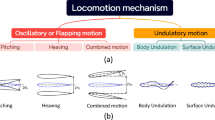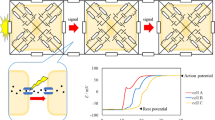Abstract
The spatial–temporal organization of the activation, repolarization and hemodynamics of the heart ventricle in rainbow trout, Oncorhynchus mykiss, adapted to a temperature of 5–7 °C, were studied from the normal sinus rhythm (21.6 ± 4.9 bpm) to the highest possible heart rhythm (HR) (60 bpm), during which deterioration of the contractile activity of the myocardium occurred. Regardless of the HR, the main pattern of excitation of the heart ventricle was the movement of the depolarization wave from the dorsal areas of the base in the base-apical and ventral directions with the capture of the entire thickness of the walls, with a slight difference in the time of activation of the subendocardium compared to the subepicardium. The increase in HR above the sinus rhythm caused significant shortening of local repolarization durations in all areas and layers (endocardial, intramural and subepicardial) of the heart ventricle. Changes in local durations of repolarization led to an increase in the heterogeneity of repolarization of the ventricular myocardium; as a result, a deterioration of its contractility was observed. In relation to the sinus rhythm, the maximal systolic pressure in the heart ventricle decreased, the diastolic and end-diastolic pressure increased, and the maximum rates of pressure rise and fall decreased. In rainbow trout adapted to a temperature of 5–7 °C at sinus rhythm, the pumping function of the heart was probably within the upper limit of the physiological norm, and a further increase in the heart rate led to a decline in myocardial contractility.





Similar content being viewed by others
Data availability
Not applicable
Code availability
Not applicable
References
Abramochkin DV, Vornanen M (2015) Seasonal acclimatization of the cardiac potassium currents (IK1 and IKr) in an arctic marine teleost, the navaga cod (Eleginusnavaga). J Comp Physiol B 185:883–890. https://doi.org/10.1007/s00360-015-0925-5
Azarov YaE, Kibler NA, Vaykshnorayte MA, Tsvetkova AS, Kharin SN, Vityazev VA, Shmakov DN (2013) Effect of heart electric stimulation on repolarization of ventricular myocardium of fish and amphibians. Zh Evol Biohim Fiziol 49:165–174. https://doi.org/10.1134/S0022093013020059
Badr A, El-Sayed MF, Vornanen M (2016) Effects of seasonal acclimatization on temperature dependence of cardiac excitability in the roach, Rutilus rutilus. J Exp Biol 219:1495–1504. https://doi.org/10.1242/jeb.138347
Bigdai EV, Samoilov VO (2004) Heterogeneity of olfactory transduction mechanisms in the Rana Temporaria frog. Zh Evol Biohim Fiziol 40:112–117. https://doi.org/10.1023/B:JOEY.0000033804.79865.4a
Casselman MT, Anttila К, Farrell AP (2012) Using maximum heart rate as a rapid screening tool to determine optimum temperature for aerobic scope in Pacific salmon Oncorhynchus spp. J Fish Biol 80:З58-377. https://doi.org/10.1111/j.1095-8649.2011.03182.x
Coyne MD, Kim KC, Cameron JS, Gwathmey JK (2000) Effects of temperature and calcium availability on ventricular myocardium from rainbow trout. Am J Physiol Regulatory Integrative Comp Physiol 278:R1535–R1544. https://doi.org/10.1152/ajpregu.2000.278.6.R1535
Endoh M (2004) Force–frequency relationship in intact mammalian ventricular myocardium: physiological and pathophysiological relevance. Eur J Pharm 500:73–86
Farrell AP, Gamperl AK, Hicks JMT, Shiels HA, Jain KE (1996) Maximum cardiac performance of rainbow trout (Oncorhynchus mykiss) at temperatures approaching their upper lethal limit. J Exp Biol 199:663–672
Farrell AP, Eliason E, Sandblom E, Clark TD (2009) Fish cardiorespiratory physiology in an era of climate change. Canad J Zool 87(10):835–851
Glukhov AV, Egorov YuV, Rozenshtraukh LV (2014) Electrophysiological mechanisms of stability of the heart rhythm of hibernating mammals during hypothermia. SuccPhysiol Sci 45:3–26
Gradill KJ, Shawn R, Garnerl SR, Chris C, Wilson CC, Anthony P, Farrell AP, Neffl BD (2016) Relationship between cardiac performance and environment across populations of Atlantic salmon (Salmo salar): a common garden experiment implicates local adaptation. Evol Ecol 30:877–886
Gubler EV, Genkin AA (1973) Application of non-parametric statistical criteria in biomedical research. Medicine. Russia, Leningrad
Haverinen J, Vornanen M (2004) Temperature acclimation modifies Na+ current in fish cardiac myocytes. J Exp Biol 207:2823–2833. https://doi.org/10.1242/jeb.01103
Haverinen J, Vornanen M (2006) Significance of Na+ current in the excitability of atrial and ventricular myocardium of the fish heart. J Exp Biol 209:549–55. https://doi.org/10.1242/jeb.02044
Hoffman B, Cranefield P (1962) Electrophysiology of the heart. Izd. foreign lit. Moscow, Russia
Jensen J, Wang T, Christoffels VM, Moorman AFM (2013) Evolution and development of the building plan of the vertebrate heart. Biochim Biophys Acta 1833:783–794. https://doi.org/10.1016/j.bbamcr.2012.10.004
Kibler NA, Nuzhny VP, Achmetzhynova SV, Shmakov DN (2017) Effects of heart rate on the pump function and electrophysiological characteristics of the heart in the frog Rana temporaria. IJBM 7(1):46–50. https://doi.org/10.21103/Article7(1)_OA5
Kibler NA, Nuzhny VP, Shmakov DN (2018) Effect of repolarization duration on the indices of the pump function of the ventricles of the heart in the animals with successive and flash-successive types activation of myocardium under ectopic excitation of the ventricles. Russ Open Med J 7: Article CID e0305
Klaiman JM, Fenna AJ, Shiels HA, Macri J, Gillis TE (2011) Cardiac remodeling in fish: strategies to maintain heart function during temperature Change. PloS One 6(9). https://doi.org/.10.1371/journal.pone.0024464
Lopatin AN, Nichols CG (2001) Inward rectifiers in the heart: an update on IK1. J Mol Cell Cardiol 33:625–638. https://doi.org/10.1006/jmcc.2001.1344
Moorman AF, Christoffels VM (2003) Cardiac chamber formation: development, genes and evolution. Physiol Rev 831223–1267. https://doi.org/10.1152/physrev.00006.2003
Nuzhny VP, Kibler NA, Shmakov DN (2018) Irregular ventricular Tachycardia as a mechanism of stabilization of mechanoelectrical processes in canine heart under conditions of antiorthostatic hypokinesia. Bull Exp Biol Med 166(8):207–212. https://doi.org/10.1007/s10517-018-4315-3
Sedmera D, Reckova M, DeAlmeida A, Sedmerova M, Biermann M, Volejnik J, Thompson RP (2003) Functional and morphological evidence for a ventricular conduction system in zebrafish and Xenopus hearts. Am J Physiol Heart Circ Physiol 284:1152–1160. https://doi.org/10.1152/ajpheart.00870.2002
Shiels HA, Farrell AP (1997) The effect of temperature and adrenaline on the relative importance of the sarcoplasmic reticulum in contributing calcium to force development in isolated ventricular trabeculae from rainbow trout. J Exp Biol 200:1607–1621
Shiels HA, Vornanen M, Farrell AP (2002) The force–frequency relationship in fish hearts — a review. Com Biochem Physiol A 132:811–826. https://doi.org/10.1016/s1095-6433(02)00050-8
Solovyova O, Katsnelson LB, Konovalov P, Lookin O, Moskvin AS, Protsenko YL, Vi-kulova N, Kohl P, Markhasin VS (2006) Activation sequence as a key factor in spatio-temporal optimization of myocardial function. Philos Transact A Math Phys Eng Sci 364(1843):1367–1383
Vaykshnoraite MA (2018) The sequence of activation of the myocardium ventricular carp (Cyprinus Carpio). Russ Physiol J Im IM Sechenov 104:238–244
Vaykshnoraite MA, Tsvetkova AS, Vityazev VA, YaE A, Shmakov DN (2009) The sequence of repolarization of the myocardium ventricular pikes. Russ Physiol J Im IM Sechenov 95:116–122
Vaykshnorayte MA, Vityazev VA, AzarovYaE, (2018) The sequence of activation of the ventricular myocardium of the Atlantic cod (Gadusmorhuamarisalbi). Proceed Komi Science Center 4(32):431–435
Vornanen M, Shiels HA, Farrell AP (2002a) Plasticity of excitation–contraction coupling in fish cardiac myocytes. Comp Biochem Physiol A 132:827–846. https://doi.org/10.1016/s1095-6433(02)00051-x
Vornanen M, Ryokkynen A, Nurmi A (2002) Temperature-dependent expression of sarcolemmal K(+) currents in rainbow trout atrial and ventricular myocytes. Am J Physiol RegulIntegr Comp Physiol 82:R1191–R1199. https://doi.org/10.1152/ajpregu.00349.2001
Vornanen M, Haverinen J, Egginton S (2014) Acute heat tolerance of cardiac excitation in the brown trout (Salmo truttafario). J Exp Biol 217(2):299–309. https://doi.org/10.1242/jeb.091272
Yang Y, Sigworth FJ (1998) Single-channel properties of IKs potassium channels. J Gen Physiol 112:665–678. https://doi.org/10.1085/jgp.112.6.665
Acknowledgements
The technical assistance of Dr. Vladimir Vityazev is gratefully appreciated.
Funding
This work was conducted in the framework of the State contract of the Institute of Physiology No. GR AAAA-A17-117012310154–6) under the Program of Fundamental Research for 2013–2021.
Author information
Authors and Affiliations
Contributions
The authors declare that they have no known competing financial interests or personal relationships that could have appeared to influence the work reported in this paper.
Corresponding author
Ethics declarations
Ethics approval and consent to participate
The study was carried out in accordance with the international rules for the treatment of experimental animals (Guide for the Care and Use of Laboratory Animals) (NIH Publication No. 85–23, ed. 1996) and approved by the local ethical Committee of the Institute of Physiology, Komi Science Centre, Ural Branch, RAS.
Consent for publication
Not applicable.
Conflict of interest
The authors declare no competing interests.
Additional information
Publisher's note
Springer Nature remains neutral with regard to jurisdictional claims in published maps and institutional affiliations.
Rights and permissions
About this article
Cite this article
Kibler, N.A., Nuzhny, V.P., Kharin, S.N. et al. Effect of atrial artificial electrical stimulation on depolarization and repolarization and hemodynamics of the heart ventricle in rainbow trout Oncorhynchus mykiss. Fish Physiol Biochem 47, 1329–1339 (2021). https://doi.org/10.1007/s10695-021-00983-0
Received:
Accepted:
Published:
Issue Date:
DOI: https://doi.org/10.1007/s10695-021-00983-0




